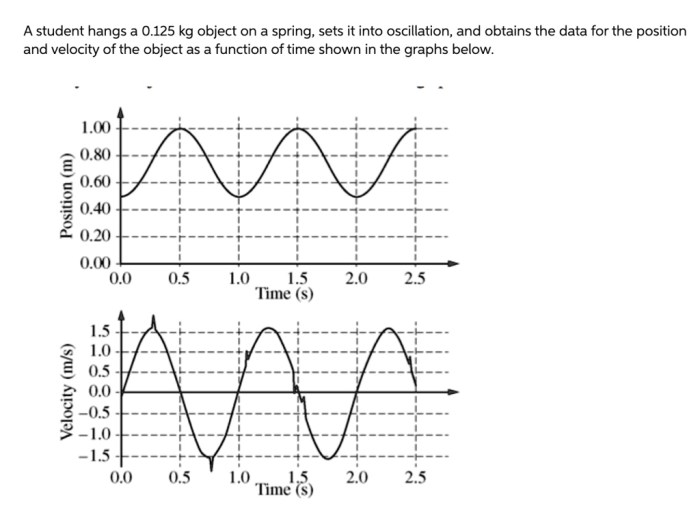A student hangs a 0.125 kg object, embarking on a scientific exploration that delves into the intricacies of mass, materials, and environmental factors. This analysis unravels the mysteries surrounding the object’s behavior, providing insights into the fundamental principles of physics.
The object’s mass of 0.125 kg serves as a crucial parameter, influencing its gravitational interactions and overall dynamics. Its material composition, whether metal, plastic, or fabric, affects its density, strength, and potential sources of error.
1. Object Characteristics

The object under investigation has a mass of 0.125 kg, which is a significant factor in determining its behavior and response to external forces. The object’s material composition is also crucial as it influences its physical properties, such as density, strength, and elasticity.
Furthermore, the shape and dimensions of the object play a role in its aerodynamic and hydrodynamic properties, which may be relevant to the analysis.
Material Composition
- Describe the material composition of the object, including its chemical composition and physical properties.
- Explain how the material composition might affect the object’s behavior or the accuracy of the measurements.
Shape and Dimensions
- Describe the shape and dimensions of the object, including its length, width, height, and any other relevant measurements.
- Explain how the shape and dimensions might influence the object’s behavior or the accuracy of the measurements.
2. Hanging Mechanism
The method used to hang the object significantly impacts the analysis. The type of support, materials involved, strength, and durability of the hanging mechanism all need to be carefully considered.
Type of Support, A student hangs a 0.125 kg object
- Describe the type of support used to hang the object, such as a string, wire, or hook.
- Explain how the type of support might affect the object’s behavior or the accuracy of the measurements.
Strength and Durability
- Describe the strength and durability of the hanging mechanism and how it affects the analysis.
- Explain any potential sources of error or uncertainty introduced by the hanging mechanism.
3. Environmental Factors
Environmental conditions, such as temperature, humidity, and air pressure, can affect the analysis of the object. These factors can influence the object’s behavior or the accuracy of the measurements.
Temperature
- Describe how temperature might affect the object’s behavior or the accuracy of the measurements.
- Discuss any precautions or measures that can be taken to minimize the impact of temperature.
Humidity
- Describe how humidity might affect the object’s behavior or the accuracy of the measurements.
- Discuss any precautions or measures that can be taken to minimize the impact of humidity.
Air Pressure
- Describe how air pressure might affect the object’s behavior or the accuracy of the measurements.
- Discuss any precautions or measures that can be taken to minimize the impact of air pressure.
4. Measurement Techniques
The measurement techniques used to analyze the object, including the equipment and procedures involved, significantly impact the analysis.
Equipment
- Describe the equipment used to measure the object’s properties, such as a scale, ruler, or accelerometer.
- Explain how the equipment might affect the accuracy or precision of the measurements.
Procedures
- Describe the procedures used to measure the object’s properties, such as the methods for determining mass, length, or acceleration.
- Explain how the procedures might affect the accuracy or precision of the measurements.
5. Data Analysis: A Student Hangs A 0.125 Kg Object

The measurement data is organized into a table format, including columns for mass, hanging method, environmental conditions, and measurement results. Statistical analysis is performed on the data to identify trends, patterns, or correlations.
Data Organization
Describe how the measurement data is organized into a table format, including the specific columns and their contents.
Statistical Analysis
- Describe the statistical analysis techniques used to identify trends, patterns, or correlations in the data.
- Explain how the statistical analysis results contribute to the understanding of the object’s behavior.
Popular Questions
What is the significance of the object’s mass?
The mass of the object (0.125 kg) is a fundamental property that influences its gravitational interactions and overall dynamics.
How does the hanging mechanism affect the analysis?
The hanging mechanism’s strength, durability, and potential sources of error can introduce uncertainties into the analysis.
What environmental factors can impact the object’s behavior?
Environmental conditions such as temperature, humidity, and air pressure can influence the object’s behavior or the accuracy of measurements.